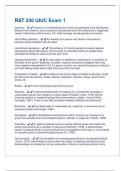RST 230 UIUC Exam 1
deviancy - ✔️✔️A person is considered deviant if they are perceived to be significantly
different from others in some important characteristic and if this difference is negatively
valued. Defined by cultural norms. EX: child marriage, female genital circumcision
self fulfilling prophecy - ✔️✔️the labeling of a person may result in the person's
behavior being consistent with the label
internalized oppression - ✔️✔️The tendency of minority people to accept negative
stereotyping about themselves. Occurs when an individual comes to accept these
stereotypical beliefs as truths and acts upon them.
spread phenomenon - ✔️✔️An association of additional "imperfection" to a person on
the basis of the actual "disabling" condition. Assume someone is disabled, then they
have negative characteristics. EX: if a person is blind, you assume the person is deaf so
you start talking louder when really they're just blind not deaf
Antecedent of beliefs - ✔️✔️Conditions that set the stage for beliefs to develop. Could
be influences like parents, media, siblings, neighbors, teachers, clergy, government,
books, etc.
Beliefs - ✔️✔️Involve what people perceive to be true
Attitudes - ✔️✔️A learned predisposition to respond in a consistently favorable or
unfavorable manner with respect to a given object (Fishbein, Ajzen, 1975) OR the
enduring positive or negative feelings about some person, object, or issue (Petty,
Cacioppo, 1981). There is very little correlation between attitudes and behaviors.
Behaviors - ✔️✔️Any observable or measurable act, response, or movement by an
individual (Datillo and Murphy, 1987).
Sterotypes - ✔️✔️A standardized mental picture held in common by members of a
group that represents an oversimplified opinion, attitude, or judgement (Datillo, 1990).
Prejudice - ✔️✔️A negative attitude toward a socially defined group and toward any
person perceived to be a member of that group (Ashmore, 1976). A preconceived
opinion or attitude which is formed without due consideration of the facts. It is not based
on scientific proof or rational thought process (Yu, 1987).
Discrimination - ✔️✔️The translation into consequential behavior of prejudicial beliefs
(Tumin, 1973). Discrimination occurs when the object of prejudice is placed at some
disadvantage not merited by his own misconduct. Actions or practices carried out by
, members of the dominant racial or ethnic groups that have a differential and negative
impact on members of a subordinate racial or ethnic groups.
Theories of discrimination - ✔️✔️Two classes of explanations for discrimination:
1. Prejudice -> Discrimination
2. Discrimination without prejudice
displacement/scapegoat theory - ✔️✔️Take out their bad day on someone else if they
can't express it
authoritarian personality theory - ✔️✔️people who see things in black and white
categorization and stereotyping theory - ✔️✔️Categorization is a process in which an
individual is identified as a member of an outgroup and treated as if the characteristics
of the outgroup applied to him personally. Categorization often leads to stereotyping
which can be a direct cause of prejudice acquisition
socialization and conformity theory - ✔️✔️no one is born racist, pick up on what's
shown around them by parents, friends, siblings, family members, teachers, etc
Core and secondary dimensions of diversity - ✔️✔️Core: traits you are born with that
are impossible or very difficult to change. These include mental/physical ability, sexual
identify, age, gender, race/ethnicity, first language.
Secondary: Social class, education, work style, communication style, organizational role
and level, geographic location, work experience, religion.
Needs and barriers experienced by multicultural customers - ✔️✔️Consumer racism
(receiving substandard service in establishments because of their race or ethnicity),
employees who are not at ease, impatient/are frustrated with multicultural customers.
Products and Policies that have not been developed with multicultural customers in
mind. Example, a shoe company that only markets towards Americans and has
American sizes.
Inclusion - ✔️✔️cultural characteristic whereby that culture is characterized by attitudes
and behaviors that are open and accepting of all people. Used to capture a sense of
belonging, value, and respect. One of the reasons people become defensive and angry
when talking about inclusion and diversity issues is because they feel blamed.
perceived racial threat (self interest) theory - ✔️✔️no real threat, just
perceived/hypothetical because they're afraid of losing their way of life
contact theory - ✔️✔️people develop prejudices against those whom they don't know
because they have never had equal status so friendship contact with them




